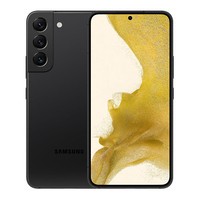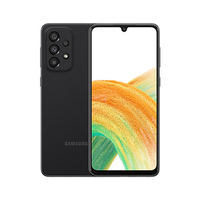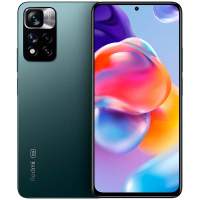Samsung Galaxy A53 review (original) (raw)
TechRadar Verdict
An attractive phone with a good-looking screen and impressive cameras for the price, the Samsung Galaxy A53 offers good value for money overall; but with its slow charging and stuttery performance, it’s not for everyone.
Pros
- Good cameras for price
- Attractive design
- Good-looking screen
Cons
- -
Slow to charge - -
Slow to navigate - -
Battery life could be better
Why you can trust TechRadar We spend hours testing every product or service we review, so you can be sure you’re buying the best. Find out more about how we test.
Two-minute review
You’re about to see a whole lot of two different adjectives: ‘attractive’, and ‘slow’. While conducting the testing for this Samsung Galaxy A53 review, we found many aspects of the phone could easily be described by one of those two adjectives.
The A53 is, for all intents and purposes, a 'lite' version of the Samsung Galaxy S22. Samsung wouldn't call it that, but it makes sense to us because the Galaxy A series typically brings lots of the Galaxy S features to a lower price point. The A53 is a great example of one of the best Samsung phones in an more affordable package.
Like the Galaxy S22 family members, the A53 has an attractive screen. In fact, since the Samsung Galaxy S22 Plus and the A53 have the same resolution and refresh rate, with only a 0.1-inch difference in screen size, we imagine that most people won’t be able to distinguish the A53 from the larger Galaxy S22 Plus without comparing both phones side-by-side.
It’s possible the A53 provides the best camera experience you can get on a phone at this price point – its four rear snappers combine with a long list of photography and videography modes that Samsung offers to let you take some surprisingly attractive pictures.
Sure, the A53's snaps won’t compare to those produced by the Galaxy S22 Ultra, but pictures were bright and vibrant, perfect for sharing on Instagram or other social platforms. That was the case for selfies too, and at a significantly cheaper price than Samsung's top phones.
And since we’re sharing our favorite things about the phone, let us also mention what other people loved: the look. While we were testing the peach version of the phone, people constantly told us how good it looks. And we mean constantly – everyone who saw it had to let us know how attractive they found it. Admittedly, this isn’t scientific proof that the peach A53 is a good-looking phone, but we’d say it’s pretty convincing that this handset is attractive.
You can get all of that for a relatively low price tag: the handset starts at 449.99/£399/AU449.99 / £399 / AU449.99/£399/AU699, which leans toward ‘affordable’ in the mid-range market. Phones at this price usually have a few strong suits and a few weak ones, and that’s the case here.

(Image credit: Future)
First of all, the Galaxy A53 is slow to charge, with its 25W charger taking up to two hours to fill up the device. Considering that cheaper phones than this come with much, much quicker powering – the Redmi Note 11 Pro Plus is more affordable and has 120W charging, for example – 25W feels far too slow.
And speaking of slow things, the phone itself drags from time to time. It didn’t stop us from doing what we needed to do on the phone, but frequently, the device stuttered, with apps freezing or scrolling slowing – more so than on other handsets at this price, which is why we raise the issue.
In this two-minute review, we used the words ‘attractive’ and ‘slow’ five times each. Those terms really do embody the device: its design, display and cameras all tick the ‘attractive’ box, but the charging speed and performance are decidedly slow.
If you’re ok with that, this mid-range Samsung phone should be on your wish list. But if you prefer performance over photography or want something a little faster, there are better options out there for you.
Alternatives that you might want to consider include the aforementioned Redmi Note 11 Pro Plus, the cheaper Samsung Galaxy A33, and - if you're not on such a tight budget - the premium Samsung Galaxy S22, among others.
It's worth noting also that we might see the Samsung Galaxy A54 within the first few months of 2023, so if you're not in a hurry then it could be worth waiting to see how that turns out.
Samsung Galaxy A53 price and availability
- Costs 449.99/£399/AU449.99 / £399 / AU449.99/£399/AU699
- Only one variant
- Mid-range price tier
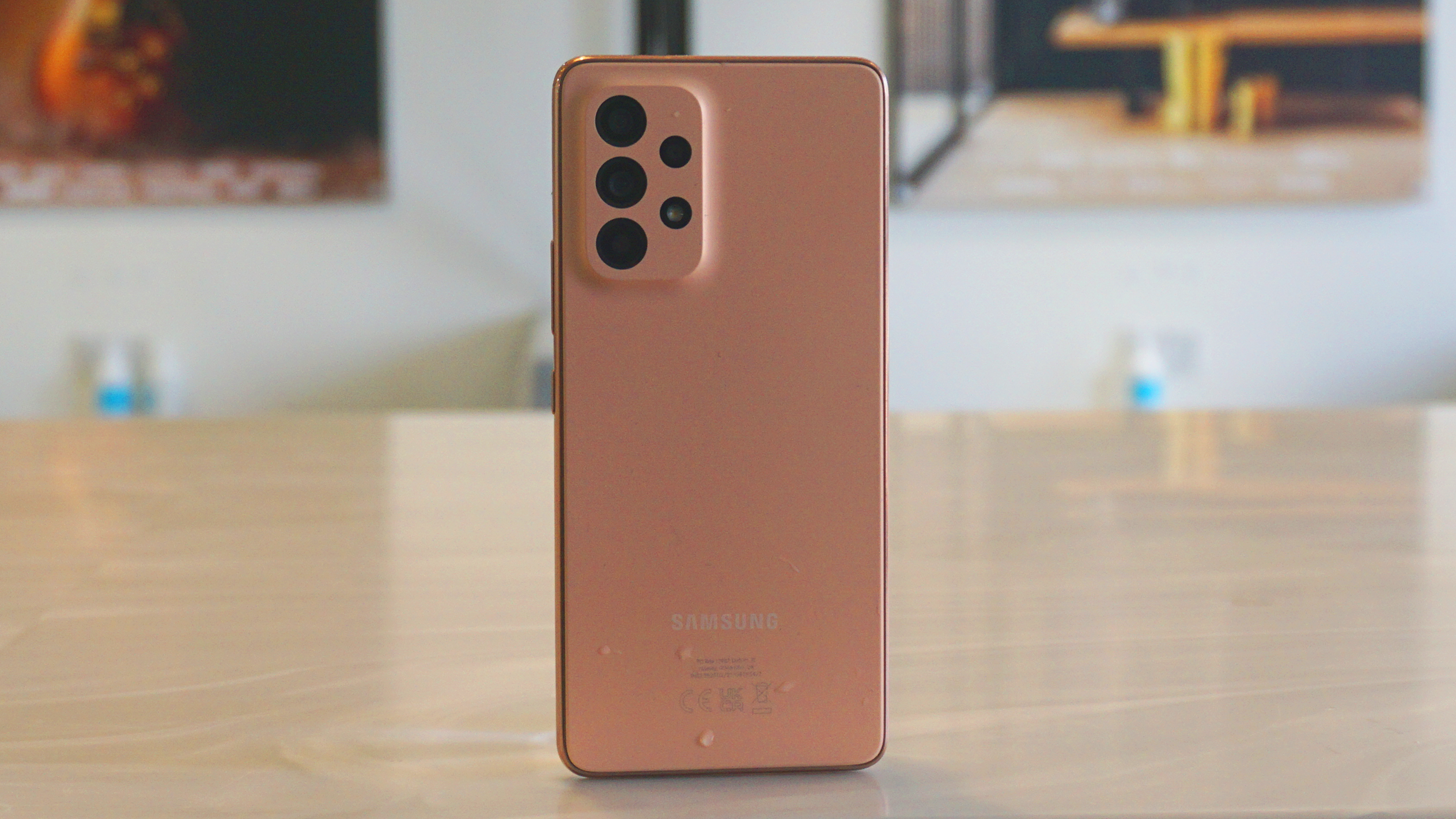
(Image credit: Future)
The Samsung Galaxy A53 price is well below those of its S-series cousins. You can pick it up for 449.99/£399/AU449.99 / £399 / AU449.99/£399/AU699 with 6GB of RAM and 128GB of storage – there are other configurations in some countries but the US, UK and Australia are all only getting the one.
In some regions, the phone is cheaper than its predecessor, the Galaxy A52, which costs 499/£399orAU499 / £399 or AU499/£399orAU799; it’s also substantially more affordable than the S22, which starts at 799/£769/AU799 / £769 / AU799/£769/AU1,249. It’s not the cheapest phone in the world, but it undercuts other devices you might be considering.
The phone went on sale in early April 2022 after a mid-March launch. It is available SIM-free or on a contract, depending on your carrier.
It's also often available for significantly less than its launch price now. Actual prices vary but shop around and you might be able to knock around $100/£100 off the prices above.
Of course, it also now has more competition, and other phones have dropped in price too, with for example the far more accomplished Google Pixel 6 sometimes selling for only a little more.
- Value score: 3.5/5
Samsung Galaxy A53 design
- Comes in peach, white, black and blue
- Mid-sized Android phone
- Understated rear camera
We complimented the phone’s design earlier, mainly because of the color. You can pick up the phone in peach, like we did, as well as white, black and blue. Samsung prefixes each of the color names with the word ‘Awesome’, but we’d feel too embarrassed to write that more than once. Your color of choice affects both the plastic back panel and the metal frame.
The phone measures 159.6 x 74.8 x 8.1mm and weighs 189g, so we’d call it medium-sized. It’s not so big that it’s uncomfortable to use, so long as your mitts aren’t massive.
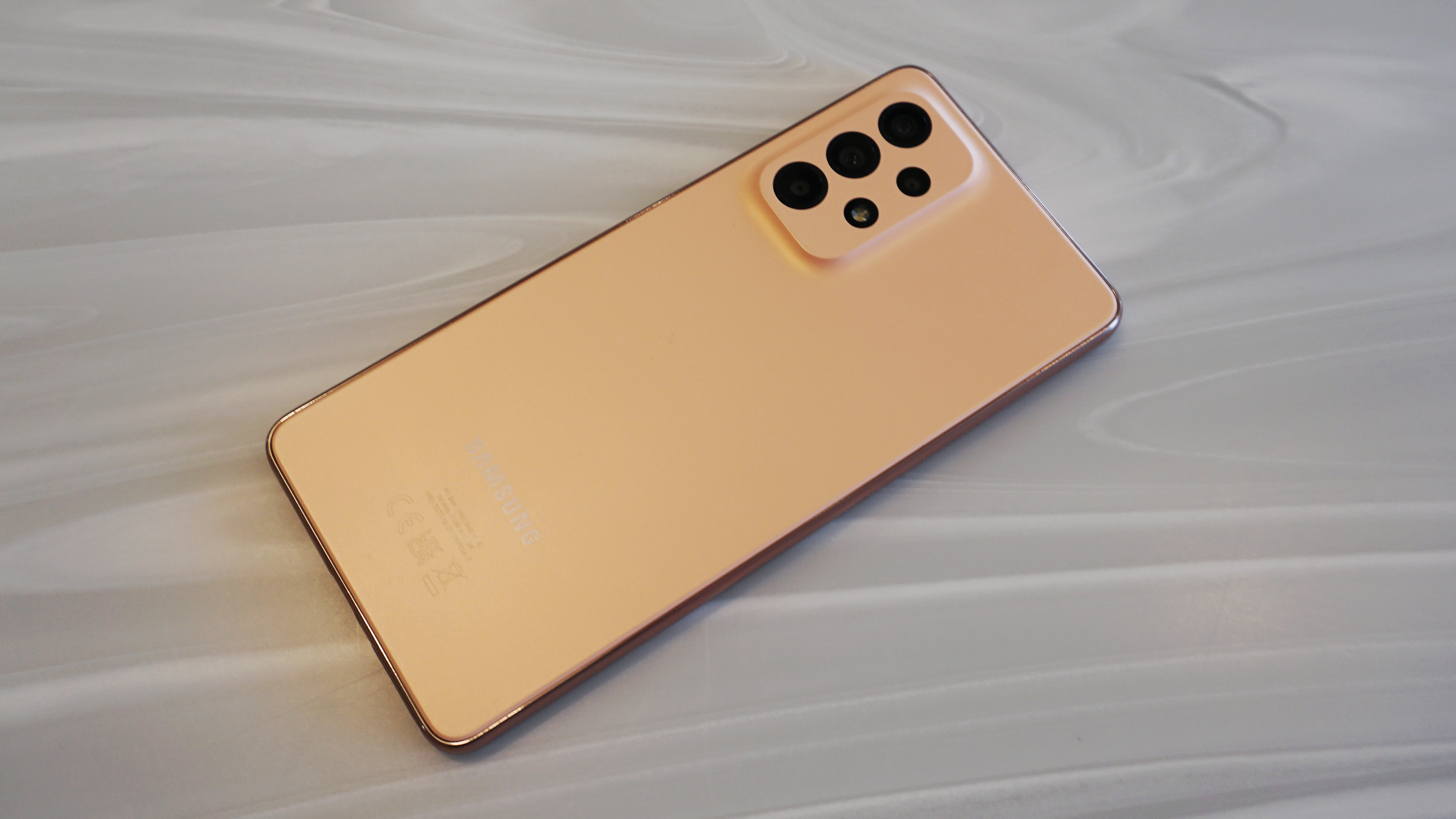
(Image credit: Future)
The right edge of the phone houses the power button and volume rocker, while the USB-C port is exactly where you’d expect it to be. There’s no 3.5mm headphone jack, unlike some other phones at this price, but there is an in-display fingerprint scanner, which we don’t see too often in phones around this price.
Sticking out from the rear, the phone’s camera bump is quite understated. This is partially because it doesn’t stick out too far, and also because the back of the device rises to meet it.
One thing we don’t like about the phone is that its rear is marred by certifications and other details – we’d really prefer our phone didn’t have the address of a PO Box in Dublin.
The Galaxy A53 has an IP67 rating, which means it’s totally dustproof and water resistant at a depth of up to a meter for 30 minutes. The plastic back also protects it against minor drops and scratches.
- Design score: 4/5
Samsung Galaxy A53 display
- Mid-size 6.5-inch screen
- FHD+ resolution, 120Hz refresh rate
- Colorful and bold AMOLED screen
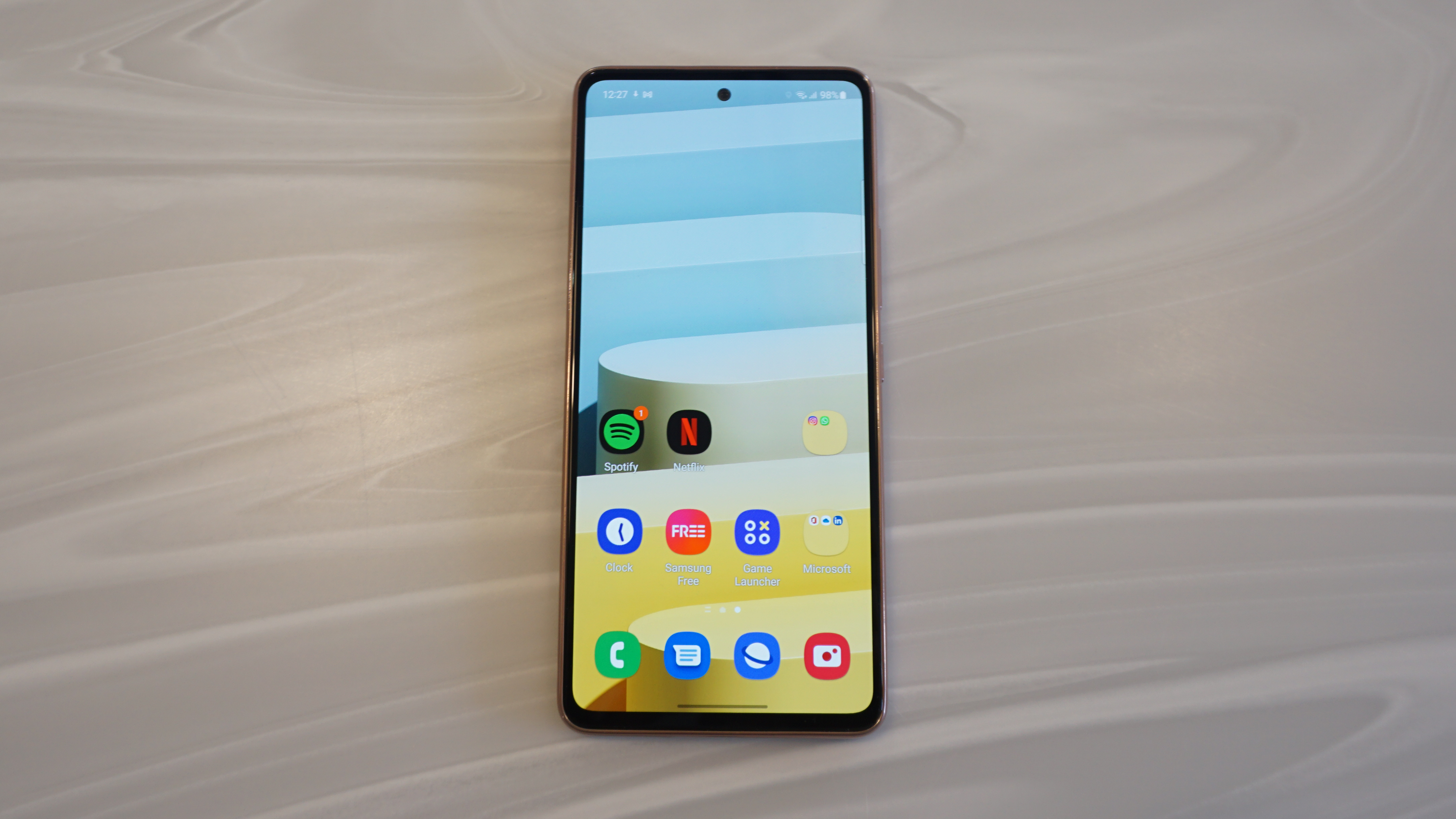
(Image credit: Future)
The Samsung Galaxy A53 boasts one of the best-looking screens you’ll see on a phone for this price.
It’s a 6.5-inch panel, with a FHD+ resolution, 120Hz refresh rate and 800 nits max brightness. With those specs, the A53 doesn’t stand out from other similarly-priced phones, but Samsung’s display tech is the real champion here, with the Super AMOLED display looking vibrant and colorful.
On paper, the A53 has the same display as the A52, but we put both phones side-by-side and found the newer one to be a little lighter – that could be because of tweaks Samsung made to its own displays, or possibly the impact of many months of use on the older phone.
The punch-hole cut-out for the front camera at the top doesn’t impinge much on your viewing space, so we quickly stopped noticing it.
- Display score: 4/5
Samsung Galaxy A53 cameras
- 64MP main, 12MP ultrawide, 5MP macro, 5MP depth sensor
- Lots of classic Samsung camera modes
- 32MP selfie camera
While the Samsung Galaxy A53’s camera performance doesn’t quite compare to that of the company’s Galaxy S phones, it laps same-price competitors with its photography game.
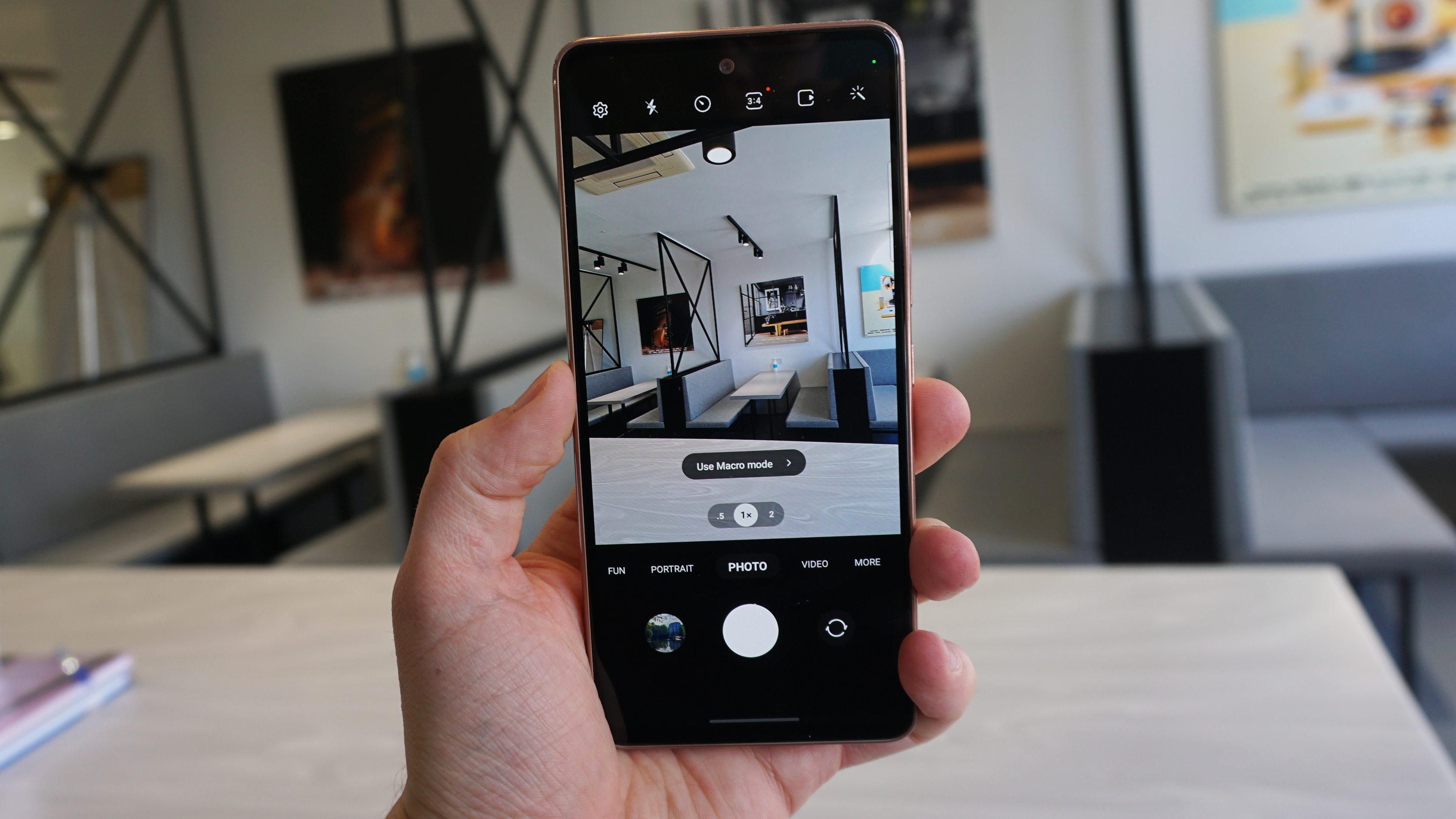
(Image credit: Future)
The main camera is a 64MP f/1.8 with a wide-angle lens, and it’s joined by a 12MP camera with an f/2.2 123-degree ultrawide lens, a 5MP f/2.4 macro and a 5MP f/2.4 depth sensor.
The snappers take photos that are bright and colorful, which makes shots of wildlife, food, landscapes or people pop. There’s high dynamic range for a phone at this price and pictures are sharp too, as long as you take them on the main camera.
Night photography is pretty good too. We took a few low-light shots that retained quite a bit of detail; it wasn’t quite iPhone-quality, but it was better than we’ve come to expect at this price tier.
If you pay attention to the budget phone market, you’ve probably seen loads of phones that slap on 2MP macro or depth cameras in order to flesh out the specs list, but that’s not the case here. The macro camera takes good-looking pictures of close-up objects, though the lens had a touch of distortion at the edges. The depth camera produced photos with fairly natural-looking background blur.
A selection of photography modes helps you make the most of the Galaxy’s array of cameras. Two in particular stand out: the Single Take, which allows you to pick a choice shot from a video, and Food mode, which lets you select a particular area of focus to create dramatic-looking shots.
With Single Take, you record a video of an object, and then an AI algorithm picks stills from it, edits and crops those images, and gives you a selection; from this set, you can pick a favorite shot.
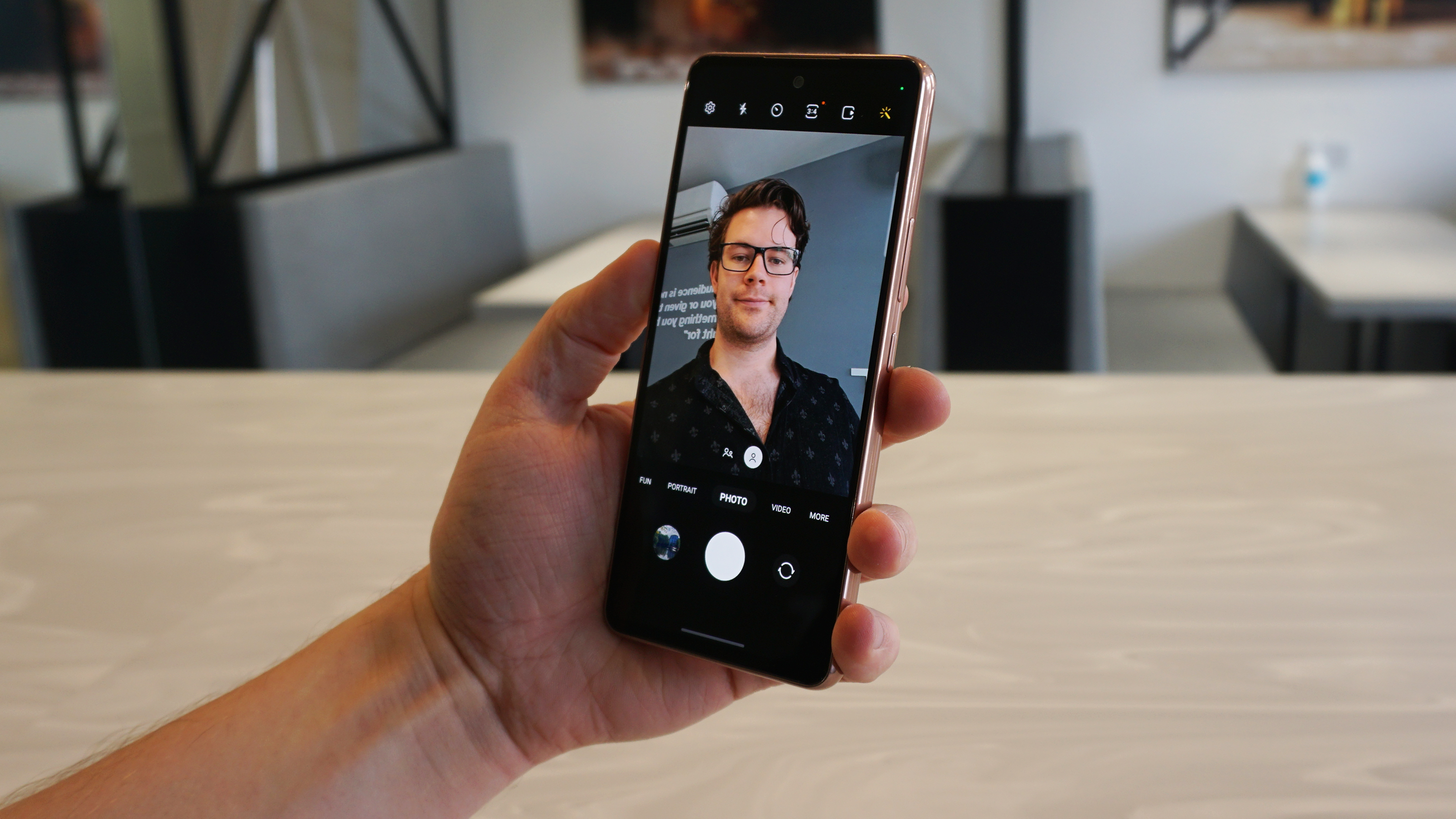
(Image credit: Future)
The Food Mode – which, despite the name, also works for things like flora and animals – lets you produce the kind of photos people love to post on social media. We sometimes found snaps produced with this mode to be oversaturated, but those are exactly what’s in vogue on social media sites.
On the front of the phone is a 32MP f/2.2 selfie camera, and this, like the rear camera, is pretty great for a mid-range phone. Snaps looked bright and vibrant, whether we were in sunny or dimmer conditions. If we have a gripe, it’s that the Bokeh in Portrait shots wasn’t always that noticeable; other than that, selfies looked great.
There’s one other camera feature, which we’re a little ashamed to admit we used. It’s called ‘Fun’ mode and it basically repackages Snapchat’s AR filters, letting you use them from the camera app. You can swap your face for clouds, add a tiara, or use a filter that just plasters the word ‘Cute’ all over your face. While this mode might be fun for some people, it’s a little outdated, and probably most welcome in Snapchat’s mid-2010s heyday.
Now on to video: you can shoot 4K video at 30fps or 1080p at 60fps on the rear cameras, but also on the front cameras. It’s rare to see a phone that offers that kind of high-res recording on the front snapper. There’s also slow-motion and ‘Super Slow-Mo,’ which does exactly what it says on the tin.
Samsung’s Pro Video mode is also here, which gives you all the options of Pro photo, including ISO and white balance, but for video. Not all of the S22 Ultra’s features are here though, as that flagship phone also lets you tweak the zoom settings on various lenses, and choose what area the microphone is recording from.
- Camera score: 3.5/5
Camera samples

A photo taken on the ultrawide camera - swipe along for 1x and zoom.(Image credit: Future)
Samsung Galaxy A53 performance and specs
- Exynos 1280 chipset
- Phone feels slow to use
- Is a 5G phone
The Samsung Galaxy A53 may lap same-price rivals in the camera and display departments, but it falls far behind when it comes to performance. The chip here is the Exynos 1280, which is a home-brewed piece of mid-range kit from Samsung – and it leaves a lot to be desired.
When we put the phone through the Geekbench 5 benchmark test, it returned a multi-core score of 1813, which puts it just below the Oppo Find X2 Lite, OnePlus Nord and Honor 9X Pro, three other mid-range phones that all came out in late 2019 or early 2020. So, not great.
The phone would often feel slow to navigate – not all of the time, but frequently. Sometimes when we were unlocking the phone, loading up apps or closing them, the handset would stutter and freeze. At times, even swiping between menu screens took a while.
This was particularly pronounced when we first started testing the phone, but it diminished over time. If you’re reading this review after just buying the thing, don’t worry – things will get better. Still, we admit that after weeks of using the A53, it still felt slower than we would have liked.
- Performance score: 2/5
Samsung Galaxy A53 software
- Android 12 software out of the box with Android 13 now available
- Samsung's One UI laid over the top
- Lots of pre-installed Google apps
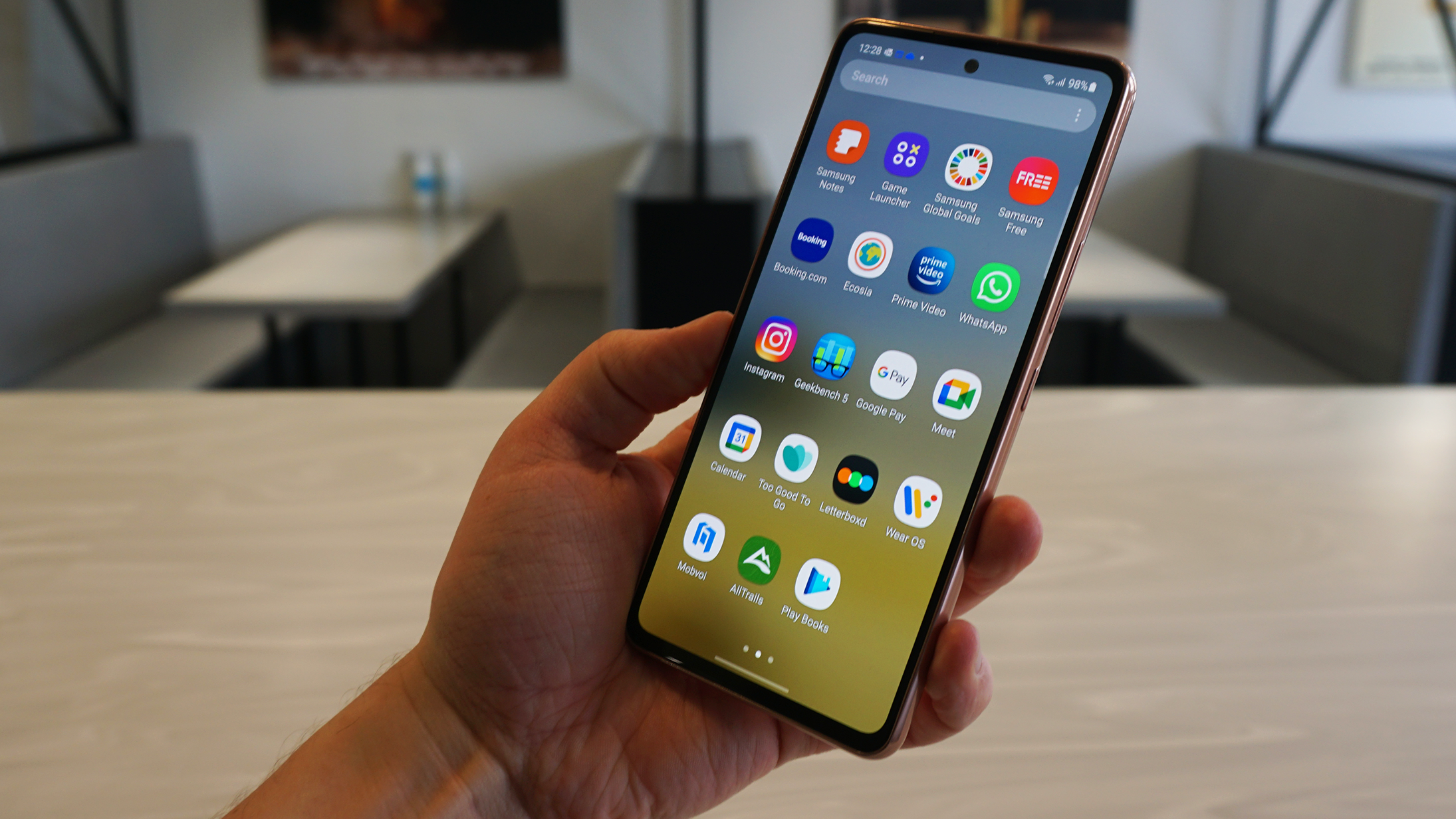
(Image credit: Future)
All of Samsung’s phones run Android with the company’s One UI laid over the top of Android – the Galaxy A53 gets Android 12 out of the box, and some of the features of this version include app hibernation (if you don’t use an app for a long period of time, it gets hidden from the menu) and Material You, which lets you change the color scheme of the phone menus to match the wallpaper.
Since launch, the Galaxy A53 has received an update to Android 13, so the software is still up to date at the time of writing.
One UI is mainly a graphical overhaul of stock Android, and you’ll either like it or you won’t; we can’t tell you what to think. But it is stuffed with Samsung’s own apps, which is confusing at times because Google’s own apps are also installed too (as on any Android phone).
There’s Samsung Pay, Gallery, Store and more, but those all have Google counterparts – Pay, Photos and Play Store. There are far more apps that dot the menus when you set up the phone, like Samsung Free, which offers a few free games, books, podcasts and TV shows; Global Goals, which just tells you what Samsung’s company goals are; and some third-party ones like Booking.com, LinkedIn and Microsoft Office.
We often criticize Chinese phone brands for bloatware, but Samsung is just as bad. As storied users of Google’s own apps for most of our functions, we had to go on a Samsung-app-deletion spree when we first booted up the device.
- Software score: 3.5/5
Samsung Galaxy A53 battery life
- 5,000mAh battery would seem rather big
- Mostly, but not always, lasted a full day
- 25W charging is slow
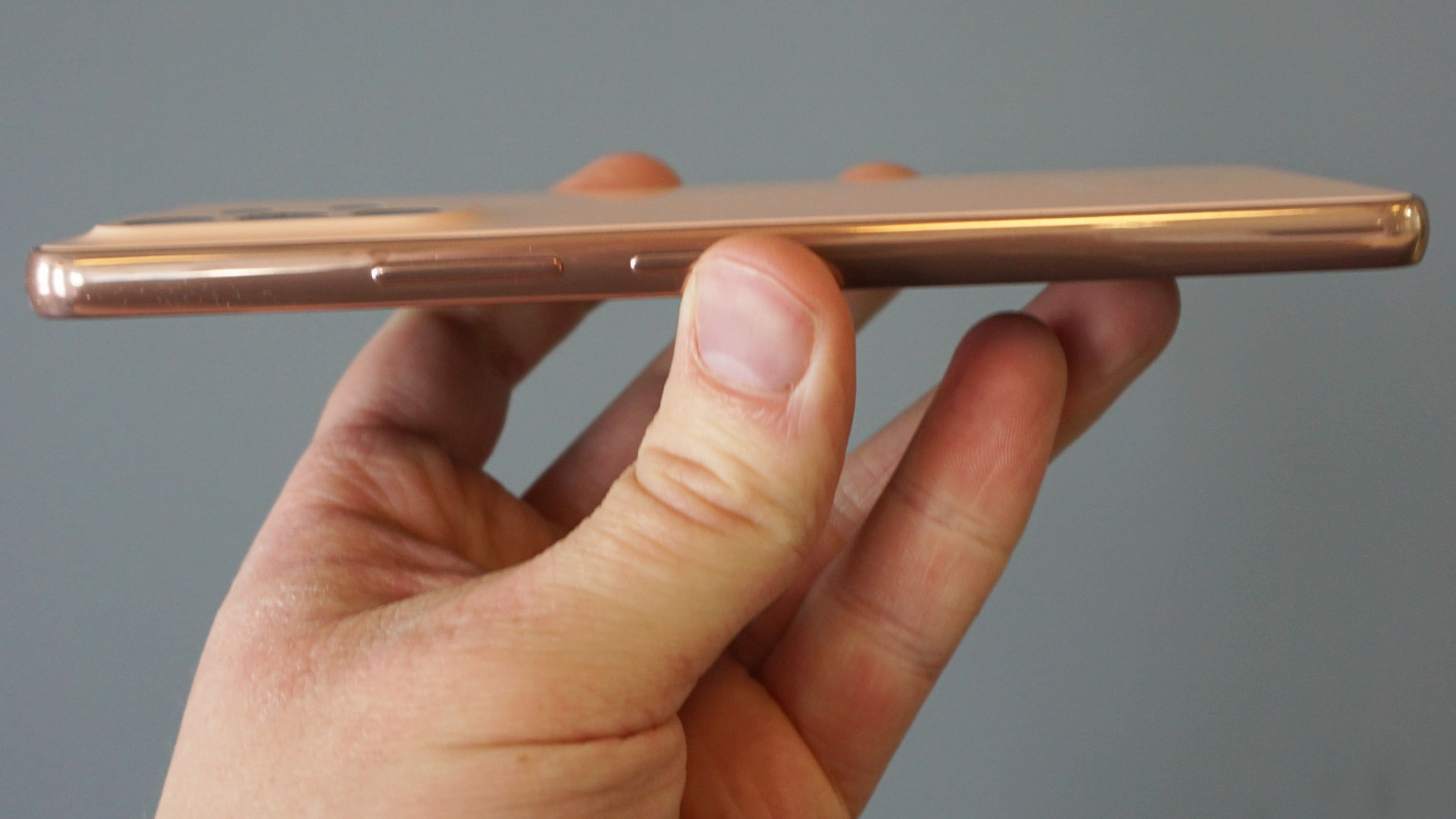
(Image credit: Future)
The Samsung Galaxy A53 has a 5,000mAh battery, which is on the big side, though we see lots of mid-rangers pack this kind of power. It comes in handy here though, as that 5G connectivity and bright screen need all the juice they can get.
In practice, we found that the phone lasted roughly a day between charges. We could get slightly more battery life if we used the thing sparingly – or less, if we spent lots of time taking photos or using the device for navigation; but a full day of use is a good ballpark figure.
While a day of use isn’t bad, mid-range phones often have fantastic battery lives, so the A53 feels a little limited. There were only a few days when we almost ran out of power while out and about, but that was enough to give us a sense of battery anxiety.
Unfortunately, charging this phone up to full takes a painfully long time. In a world with super-budget 80W and 120W charging smartphones, the Galaxy’s 25W just doesn’t cut it.
In our testing, it took over two hours to power up the phone from empty to full – that’s too long for a quick early-morning pre-work charge, but not long enough to justify overnight charging, unless you want to damage your battery over time.
- Battery score: 2/5
Samsung Galaxy A53 review scorecard
Swipe to scroll horizontally
| Attributes | Notes | Rating |
|---|---|---|
| Design | This is an attractive smartphone, as long a you buy one of the more colorful options. | 4/5 |
| Display | The Samsung Galaxy A53 has one of the best displays at its price tier. | 4/5 |
| Performance | This phone is painfully slow for its price, and it could lead to frustration if you need a fast phone. | 2/5 |
| Camera | For its price, the Galaxy A53 is great for photography. | 3.5/5 |
| Battery | The A53's battery life doesn't exactly impress, but its charging speed is downright annoying. | 2/5 |
| Software | Samsung's One UI will either impress or annoy you depending on your software tastes. | 3.5/5 |
| Value | The Samsung Galaxy A53 does give you some surprisingly top-end specs for its price in certain departments, but in other areas it's weaker than the competition. | 3.5/5 |
Should I buy the Samsung Galaxy A53?
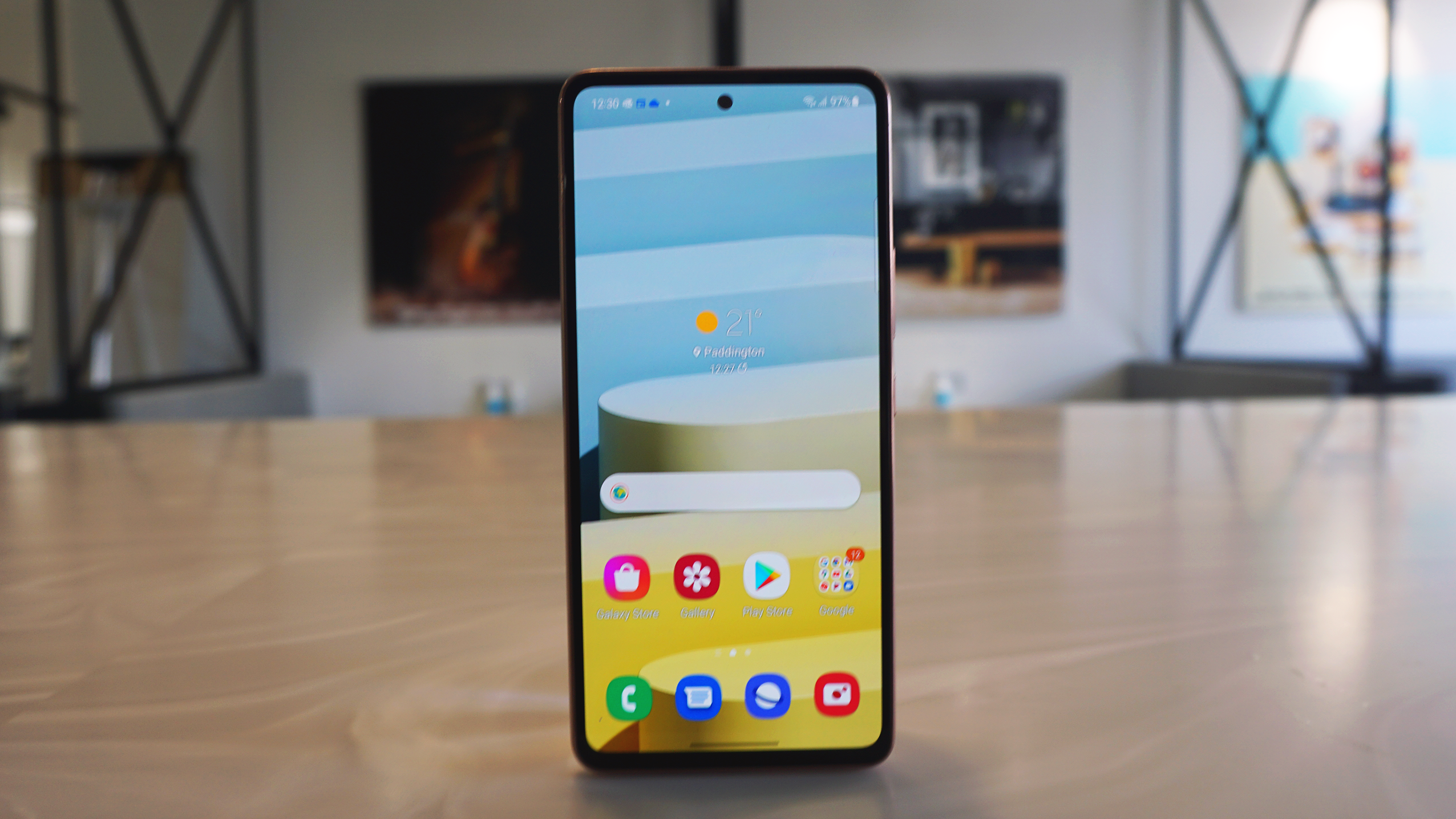
(Image credit: Future)
Buy it if...
You take pictures for social media
The Samsung Galaxy A53 takes bright pictures that take little time to edit into Instagram- or YouTube- ready packages. That’s as true for macro snaps as it is for selfies or videos.
You want to draw eyes
Usually, you need a foldable phone to draw eyes at a party – not so with the peach or blue Galaxy A53 phones, which are attractive enough to garner heaps of praise.
You watch loads of videos
If Netflix, Prime Video or YouTube is your most-used app, the Galaxy’s good-looking screen will perfectly complement your use habits.
Don’t buy it if…
You’re a mobile gamer
The Samsung Galaxy A53 doesn’t have the chops to compete with other mid-range phones in the performance department, making it sub-par for gaming.
You need fast charging
Two hours to charge to full is incredibly slow for any smartphone in 2022, and we can’t recommend the A53 if you like your quick-powering sessions.
You need a battery superhero
Some mid-range and budget phones can last for over two days on a single charge. Not the Samsung Galaxy A53, which will generally last you about a day.
Also consider
Samsung Galaxy S22
The Samsung Galaxy A53 is basically a ‘Lite’ version of the S22 – the S model is smaller but has a better camera array and much more processing power.
Check out our Samsung Galaxy S22 review
Samsung Galaxy A33
Not convinced you need all the bells and whistles of the A53? It has a budget sibling in the A33, which has the same chipset but worse cameras and a smaller screen.
Check out our hands-on Samsung Galaxy A33 review
Xiaomi Redmi Note 11 Pro Plus
This is the opposite to the A53, despite having the same price. Redmi’s Note 11 Pro Plus is powerful and charges very quickly, but it has a utilitarian design and is so-so in the camera department.
Check out our Xiaomi Redmi Note 11 Pro Plus review
- First reviewed: May 2022
How we test
We pride ourselves on our independence and our rigorous review-testing process, offering up long-term attention to the products we review and making sure our reviews are updated and maintained - regardless of when a device was released, if you can still buy it, it's on our radar.
- See our Samsung promo codes page for this month's best discounts

Tom Bedford was deputy phones editor on TechRadar until late 2022, having worked his way up from staff writer. Though he specialized in phones and tablets, he also took on other tech like electric scooters, smartwatches, fitness, mobile gaming and more. He is based in London, UK and now works for the entertainment site What To Watch.
He graduated in American Literature and Creative Writing from the University of East Anglia. Prior to working on TechRadar, he freelanced in tech, gaming and entertainment, and also spent many years working as a mixologist.
